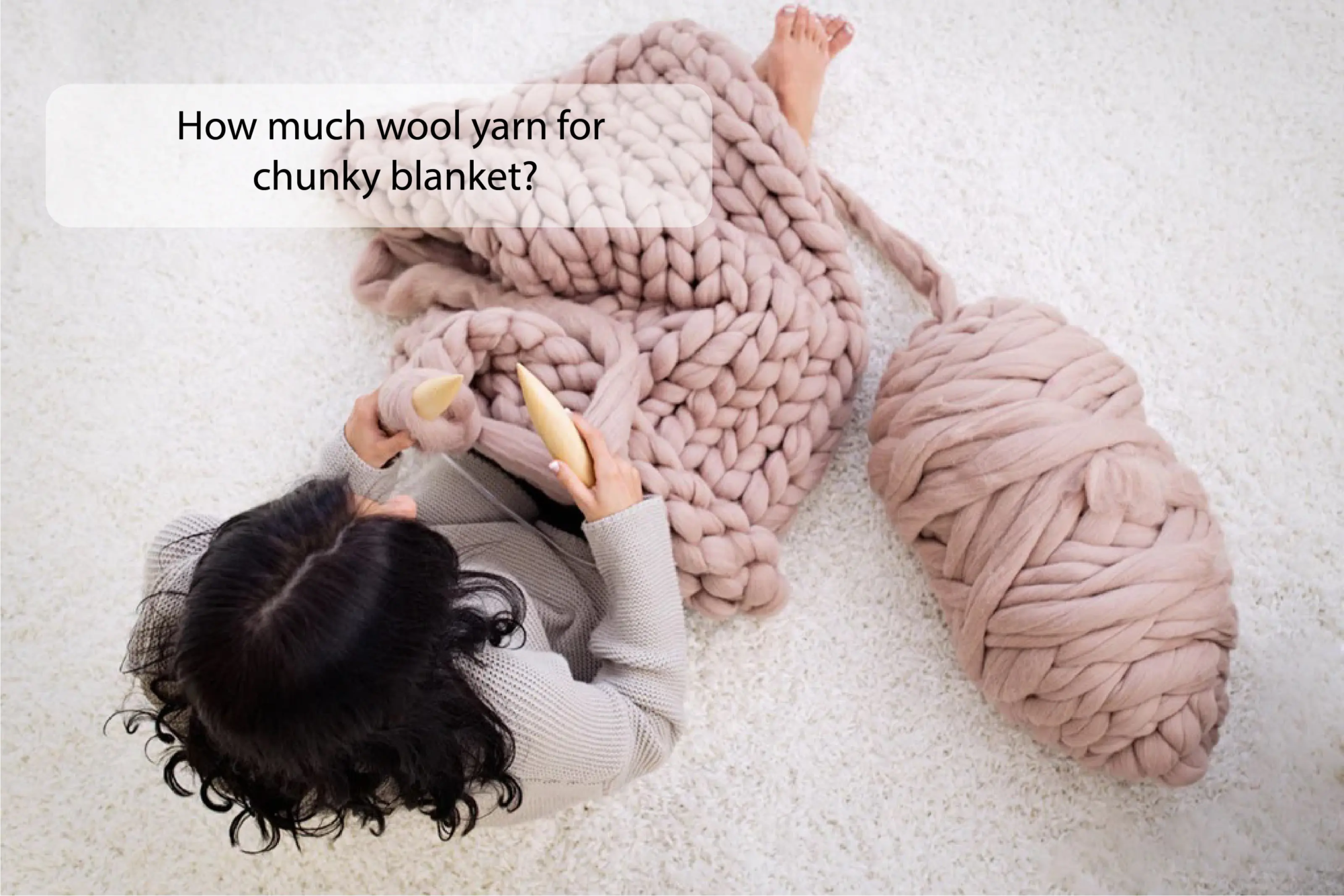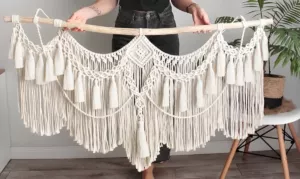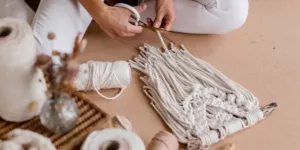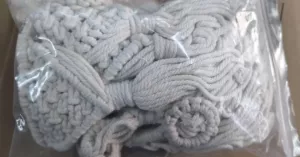Chunky blankets have surged in popularity for their remarkable comfort and stylish aesthetic. Known for their soft, oversized stitches, these blankets not only provide exceptional warmth but also add a touch of modern elegance to any decor. Not to mention, the tactile experience of working with chunky yarn is a genuine treat for many crafters—beginners and veterans alike.
When embarking on the creation of these cozy masterpieces, one crucial step is estimating the correct amount of wool yarn. Misjudgments here could lead to unexpected project halts or excess material, thus impacting both budget and satisfaction.
In this blog post, we’ll navigate the ins and outs of choosing the right quantity of wool yarn for your chunky blanket. We’ll cover key factors that influence yarn requirements, provide easy-to-follow formulas for precise estimation, and offer practical tips to enhance your crafting experience. Whether you’re planning a petite throw for chilly evenings or a king-sized comforter for your bedroom, understanding how to gauge your yarn needs will set the foundation for a rewarding knitting or crocheting journey. Let’s dive into the world of chunky knits and unravel the secrets to a successful blanket project!
Understanding Chunky Yarn
Chunky yarn, often described as bulky or super bulky in the crafting world, is a thick, cozy yarn that knits up quickly and provides a rich texture to any project it becomes a part of. Its luxurious thickness is what makes it a go-to choice for those seeking to create warm, inviting blankets with that sought-after plush feel. The appeal of chunky yarn lies not just in the tactile satisfaction it offers to the crafter, but also in the visual and physical warmth it brings to spaces it inhabits.
Characteristics of Wool Yarn Suitable for Chunky Blankets
Wool yarn is celebrated for its versatility, warmth, and durability, making it an ideal choice for chunky blankets. When selecting wool yarn for such a project, consider the following characteristics:
- Fiber Strength and Elasticity: Wool’s natural strength and elasticity make it resilient to wear and tear, an essential factor for blankets that invite frequent use.
- Thermal Properties: Wool inherently insulates, ensuring that blankets provide warmth even during the coldest of nights.
- Softness: Merino wool, for instance, is renowned for its softness against the skin, making it a preferred wool variant for blankets.
- Care Requirements: Some wool yarns can felt or shrink when washed incorrectly, so it’s important to choose a yarn that suits your care preferences, whether that’s hand-washing or opting for superwash wool that can withstand machine washing.
Types of Wool Yarn and Their Effects on the Finished Blanket
- Merino Wool: Known for its incredible softness and less itchiness compared to other wools. Blankets made with merino wool are luxuriously soft, making them perfect for snuggling.
- Alpaca Wool: Offers superior warmth and softness. Alpaca wool tends to be lighter than sheep’s wool, contributing to a chunky blanket that’s warm without being overly heavy.
- Peruvian Highland Wool: A blend of merino and Corriedale wool, combining the softness of merino with the durability of Corriedale. This yarn brings loft and a slight sheen to blankets, adding a touch of elegance.
- Pure New Wool: Also known as virgin wool, this is wool taken directly from a lamb’s first shearing. It’s highly durable and resilient, ideal for family heirlooms or blankets that will see a lot of use.
- Superwash Wool: Treated wool that allows for easy care, resisting felting and shrinking. A blanket made from superwash wool combines the natural beauty and warmth of wool with convenience.
Each type of wool yarn brings its unique touch to the fabric of a chunky blanket, affecting everything from the feel and warmth to care requirements and overall aesthetic. Choosing the right wool yarn for your project means considering the end use of the blanket, the desired care routine, and of course, the yarn’s feel and appearance. Whether you opt for the velvety caress of merino or the lightweight warmth of alpaca, your wool yarn choice will turn your chunky blanket into a cherished piece of handcrafted comfort.
Factors Affecting Yarn Quantity
Creating a chunky blanket that perfectly matches your vision requires careful consideration of several factors, each influencing how much yarn you’ll need. From the size of the blanket to the specific characteristics of the yarn and stitches used, understanding these elements ensures you have enough material to complete your project without unnecessary interruptions or excess. Let’s explore these factors in detail:
Blanket Size
The size of your blanket is the most straightforward factor affecting yarn quantity. Whether you’re creating a cozy throw for the sofa, a twin-size blanket for a child’s bed, or a luxurious king-size spread for your master bedroom, the dimensions of your finished product will directly impact the amount of yarn you need. Common blanket sizes are as follows:
- Throw: Ideal for wrapping around your shoulders or draping over a sofa.
- Twin: Suitable for a single bed, providing ample coverage without excessive overhang.
- Queen: Designed to fit a queen-size bed, with more generous dimensions for shared use.
- King: The largest standard size, offering maximum coverage and warmth for king-size beds.
Yarn Thickness
The thickness of your yarn plays a critical role in determining how much will be needed for a blanket. Yarns are categorized by weight, from lightweight (fine) to heavyweight (jumbo). Chunky blankets typically utilize bulky, super bulky, or jumbo yarns. The thicker the yarn, the more volume it occupies, potentially reducing the overall quantity required. However, thicker yarns often come in shorter lengths per skein or ball, which is an important consideration when purchasing materials.
Desired Density of the Blanket
The density or thickness of the finished blanket also affects yarn quantity. A denser blanket with closer stitches will require more yarn than a looser, airier design. The choice between a denser, warmer blanket and a lighter one influences both the aesthetic and functional aspects of the project.
Stitch Pattern and Tension
The stitch pattern you choose has a significant impact on yarn consumption. Some stitches, like stockinette or simple crochet stitches, are relatively yarn-efficient, while others, such as cable or bobble stitches, use up more yarn to create texture.
Tension, or how tightly or loosely you knit or crochet, also makes a difference. Tighter tension consumes less yarn, but it may make the blanket less drapey than desired. Conversely, looser stitches use more yarn but can contribute to a softer, more flexible blanket.
When planning your chunky blanket project, consider these factors holistically. Estimating yarn quantity accurately requires a nuanced understanding of how these elements interact. Experimenting with swatches or consulting pattern guidelines can provide valuable insights into the specific yarn requirements for your desired blanket size, yarn type, stitch pattern, and tension.
Estimating Yarn Requirements
Estimating yarn requirements accurately is essential for any knitting or crochet project, particularly when creating a blanket. Having a clear understanding of how to calculate yardage can spare you from running out of yarn mid-project or over-purchasing. Here, we discuss some basic formulas and tools that can help you estimate yarn requirements more reliably.
Basic Formulas to Determine Yardage
The amount of yarn needed for a blanket is influenced by the blanket’s size, the yarn weight, and the stitch pattern. A simple formula can get you started, although remember, it’s a rough estimate:
- Calculate the area of the blanket in square inches (or square centimeters). For a rectangular blanket, multiply the length by the width.
- Understand the yarn’s coverage. This is how many square inches one skein of your chosen yarn will cover, which can be approximated from a swatch.
- Use the formula:
[ \text{Total Yardage} = (\text{Area of the Blanket} ÷ \text{Coverage Area of One Skein}) × \text{Yardage of One Skein} ]
Examples of Calculations for Common Blanket Sizes
Let’s use the formula above to calculate yarn requirements for a 50” x 60” throw blanket using super bulky yarn. Assume from your swatch that one skein (100 yards) covers approximately 25 square inches.
- Calculate the area of the blanket: (50 \text{ in} × 60 \text{ in} = 3000 \text{ sq in})
- Calculate total yardage: ((3000 ÷ 25) × 100 = 12000 \text{ yards})
This is an oversimplified example and actual yardage will depend on factors like stitch pattern and tension, but it provides a basic starting point.
Tools to Help Estimate Yarn Amounts
To aid in your calculations and make estimating easier, several tools and resources are at your disposal:
- Yarn Calculators: These online tools allow you to input details about your project, such as dimensions, yarn weight, and gauge, and they calculate the required yardage for you. Examples include the Crochet Crowd Yarn Calculator and the LoveCrafts Yarn Calculator.
- Yarn Requirement Charts: Published by yarn manufacturers and craft organizations, these charts offer estimated yardages for various types of projects (e.g., blankets, sweaters) based on yarn weight and project dimensions.
- Knitting and Crochet Apps: Some apps include built-in calculators or tools to help you estimate yardage based on your specific project parameters.
- Creating a Swatch: Not a tool but a method. Knit or crochet a 10” x 10” swatch using the yarn and stitch pattern intended for the project. Measure how much yarn this swatch requires, then scale up to the size of your project. This method can provide a highly accurate estimate and is particularly recommended for unique or textured stitch patterns.
While these formulas and tools provide a good starting point, always buy a little more yarn than your estimate suggests to account for variances in tension or mistakes. Additionally, ensure your yarn is from the same dye lot to avoid color discrepancies in your blanket.
Practical Tips for Yarn Purchase
When embarking on a knitting or crochet project, purchasing yarn is an exciting step but requires careful consideration to ensure you have enough material to complete your work without interruption. Below are practical tips for yarn purchase, highlighting how to account for unexpected adjustments, the importance of dye lot considerations, and options for selecting eco-friendly and sustainable wool yarn.
Buying Slightly More Yarn Than Estimated
- Buy Extra Yarn: Always purchase at least 10-20% more yarn than your calculations indicate. This extra buffer accounts for errors, gauge adjustments, or even a decision to add to the project’s length or width. It’s particularly useful if your project involves complex stitch patterns that might consume more yarn than expected.
- Swatching: Use part of the extra yarn to create a swatch. This not only helps in estimating how much yarn you’ll need more accurately but also ensures that you’re happy with the fabric’s drape and feel before committing to the full project.
- Project Flexibility: Having extra yarn means you have the flexibility to modify your project as you go, whether it’s adding borders, increasing dimensions, or incorporating additional design elements.
Considerations for Dye Lot Differences
- Understanding Dye Lots: Yarn from the same dye lot has been dyed in the same vat and thus will match in color exactly. Different dye lots can have slight variations in shade, which could be noticeable in your finished project.
- Purchase Enough from the Same Dye Lot: When buying your yarn, ensure all the skeins are from the same dye lot to avoid color mismatches. If you’re unable to buy extra yarn initially, note down the dye lot number so you can try to match it later if needed.
- Strategic Use of Different Dye Lots: If you’re forced to mix dye lots, you can alternate skeins from different lots every few rows to help blend the colors and minimize the visual impact of any discrepancies.
Options for Purchasing Eco-Friendly and Sustainable Wool Yarn
- Natural Fibers: Choose yarns made from natural fibers like organic wool, alpaca, or cotton. These fibers are renewable and biodegradable, making them more environmentally friendly than synthetic alternatives.
- Organic Wool: Look for wool yarn that is certified organic, which ensures that the sheep were raised without the use of synthetic hormones or pesticides, and the wool was processed without harmful chemicals.
- Sustainably Sourced: Many companies now offer wool yarn that is sustainably sourced. This can mean different things, such as supporting small farms, ensuring animal welfare, or using eco-friendly processing methods. Look for certifications and detailed product information when making your selection.
- Recycled Yarn: Some yarns are made from recycled wool, which reduces waste and the environmental impact associated with new materials’ production.
- Local Yarns: Purchasing yarn from local farms or producers can significantly reduce the carbon footprint associated with transport. Plus, it supports local businesses and economies.
When choosing yarn for your next project, consider these tips to not only ensure a successful outcome but also to support sustainable and responsible yarn production. With a bit of planning and mindful selection, your crafting can have a positive impact on the environment and yield beautiful, high-quality results.
Starting Your Chunky Blanket
Starting a chunky blanket can be a wonderfully satisfying project, resulting in a cozy, textured piece perfect for snuggling. Chunky yarn works up quickly and can be especially gratifying for both novice and experienced knitters or crocheters. Here’s how to get started on the right foot with your chunky blanket project.
Selecting the Right Needles or Hooks for Chunky Yarn
- Size Matters: Chunky yarn requires larger needles and hooks. The yarn label usually suggests an appropriate size, but sizes 10mm (US 15) and above are common for chunky yarn. Using the right size helps maintain the correct gauge and ensures the fabric has the desired drape.
- Material Considerations: Wooden or bamboo needles/hooks tend to grip chunky yarns better, making them easier to handle, especially for beginners. Metal needles/hooks are smoother and allow for faster work but might be slippery with chunky yarns.
- Circular Needles for Knitting: Even if you’re knitting a flat blanket, circular needles can be more comfortable to use because they can accommodate the large number of stitches more easily, and the weight of the project rests on your lap, not the needles.
Casting On and Sample Stitches for a Chunky Blanket
- Simple Cast-On for Beginners: For knitting, the long-tail cast-on is a good, sturdy choice for chunky blankets. It’s versatile and creates a neat edge. For crochet, simply create a slip knot and then chain the desired width of your blanket.
- Sample Stitches: Before starting your blanket, work up a swatch to check your tension and see how the yarn behaves. Knit or crochet a 10×10 cm (4×4 inch) square. This helps adjust needle/hook size if needed and allows you to calculate how much yarn you’ll need more accurately.
- Stitch Suggestions: For chunky yarn, simple stitches often look best and make the project quick to complete. Garter stitch (knitting every row) or single crochet throughout can create a dense, warm blanket. For a more textured effect, try seed stitch (knit 1, purl 1 on every row) or include some easy cables.
Advice on Maintaining Even Tension
- Practice Makes Perfect: Tension comes with practice. Work on some swatches to get comfortable handling the yarn and tools. Over time, your hands will learn the right amount of yarn to feed into each stitch.
- Hold Your Yarn Consistently: Find a comfortable way to hold your yarn and stick with it. Consistency is key to maintaining even tension. Some people wrap the yarn around their fingers, while others let it flow freely.
- Relax Your Grip: It’s common to grip the needles or hooks tightly when working with chunky yarn, but try to relax your hands. A death grip can tire your hands more quickly and make your tension tighter than desired.
- Take Breaks: Working with chunky yarn and large tools can be taxing on your hands and wrists. Take frequent breaks to stretch and rest your hands. This helps prevent cramping and maintains consistent tension.
Starting a chunky blanket is an exciting project that leads to impressive results. With the right tools and techniques, you can create a cozy masterpiece that’s both comforting and beautiful. Remember to enjoy the process as you watch your blanket quickly grow.
Troubleshooting Common Issues
When working with chunky yarn to create your blanket, you might face several common issues that can impact the flow of your project. Here’s how to troubleshoot these problems, ensuring smooth progress and a beautiful finish.
Running Out of Yarn and How to Handle It
- Estimate Correctly: Before starting, ensure you have enough yarn. Calculate based on your gauge swatch, then add 20% more as a buffer. If you’re following a pattern, check the total yardage required and match this with your yarn.
- Finding More Yarn: If you run out mid-project, try to find the same color and dye lot. If the dye lot differs, you can alternate skeins to blend the colors (use two rows from one skein and two from another, switching back and forth).
- Alternative Solutions: If you can’t find more yarn, consider making the blanket a bit smaller or finishing with a border in a complementary color or different yarn that coordinates well.
Managing Joins When Adding New Skeins
- Joining Techniques: For knitting, try the “felted join” method (if your yarn content allows felting), which involves lightly felting the ends of your yarn together to eliminate knots. For both knitting and crochet, you can also use the “overlap join,” where you overlap a few inches of the old and new yarn and work with double yarn for a few stitches.
- Hiding the Joins: Ensure joins occur at the edge of the work where they can be hidden within the seam or a border. Plan your project so that new skeins begin at the start of rows or rounds to keep the work looking neat.
- Securely Fasten Ends: Leave a tail of about 6 inches of the old and new yarn when joining. These ends can be woven into your work with a tapestry needle, securely hiding them within the stitches.
Dealing with Variations in Yarn Thickness
- Adjusting Tension: Chunky yarn can be inconsistent. Adjust your tension as you go—loosen your grip if the yarn gets thicker, and tighten if it becomes thinner to keep your stitches looking uniform.
- Consistent Gauge: Check your gauge often to make sure variations in yarn thickness aren’t affecting the overall size and look of your blanket. It might be necessary to change needle or hook size in response to significant changes in yarn thickness.
- Embracing the Texture: Variations in thickness can add unique texture and character to your blanket. If the variations aren’t too extreme, consider embracing this as a feature of your handmade creation rather than a flaw.
By being prepared to handle these common issues and knowing how to troubleshoot them efficiently, you’ll likely find the chunky blanket project more enjoyable and less frustrating. Remember, a bit of patience and flexibility can lead to a wonderfully unique and cozy finished product.
Conclusion
Creating a chunky blanket is a journey filled with texture, warmth, and personal expression. Throughout this guide, we’ve explored various aspects of tackling such a project, from choosing the right tools to addressing common challenges along the way. One crucial component to ensure your chunky blanket project is successful and fulfilling is estimating yarn accurately.
Remember, starting with a gauge swatch is key. This initial step helps not only in assessing how much yarn you will use but also in achieving the desired size and drape of the blanket. Based on your gauge, calculate the yardage needed for your project then add a 20% buffer to account for any variations in yarn weight or to compensate for any potential mistakes along the way. This preparatory step is crucial in mitigating the risk of running out of yarn and facing inconsistencies in dye lots.
As you embark on your chunky blanket venture, we encourage you to share your progress, finished projects, and experiences with the wider crafting community. Whether it’s through social media, crafting forums, or local knitting groups, sharing can inspire others, provide valuable feedback, and even garner tips and tricks that could aid in your next project. The shared stories and images of cozy creations knit together a community, celebrating both the challenges overcome and the joyous outcomes of your labor.
Wool yarn, with its warmth, versatility, and tactile pleasure, offers an unparalleled crafting experience, especially when it comes to creating cozy items like chunky blankets. Its forgiving nature and the satisfying quick progress make working with wool a real joy. Not only does wool provide a comforting weight and warmth, but it also brings a touch of luxury and homeliness to any space.
The act of creating something with your hands from wool yarn is both grounding and gratifying. Each stitch is imbued with personal touch, effort, and intention, culminating in a unique and cherished item that can be enjoyed for years to come. Whether draped over a sofa, wrapped around a loved one, or gifted to a friend, chunky wool blankets serve as a tangible manifestation of creativity and comfort.
So, embrace the adventure that is creating with chunky wool, share your journey and let the warmth of your creations spread far and wide. Happy crafting!









